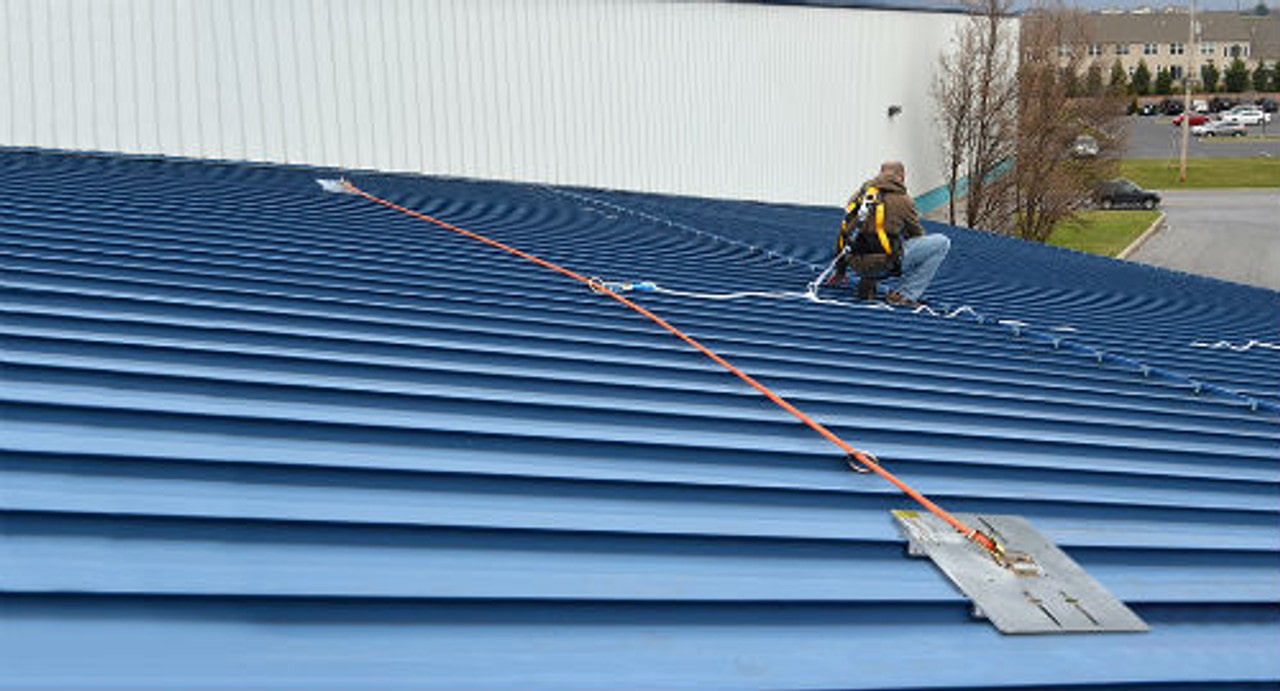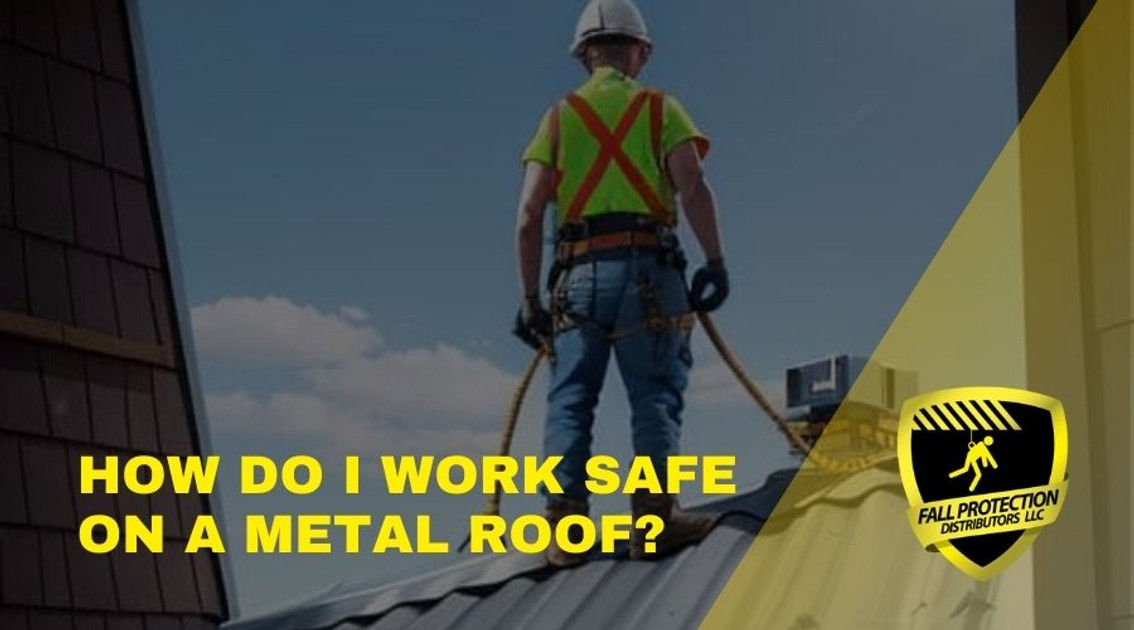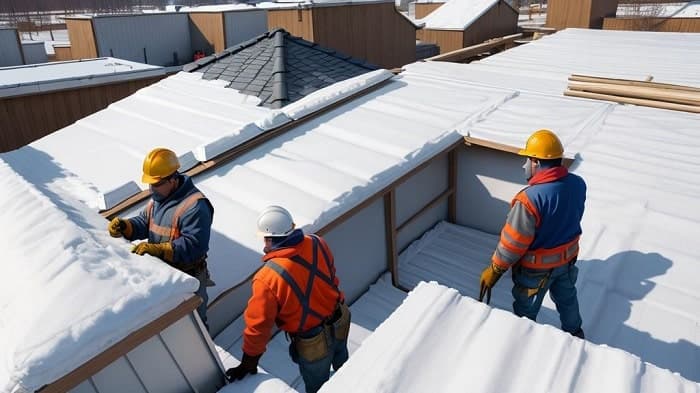How Do I Work Safe On Metal Roofs? Q&A
Posted by Howie Scarboro - CEO Fall Protection Distributors, LLC on Feb 20th 2024
Ensuring worker safety on metal roofs requires a deep understanding of the unique challenges and risks associated with this type of construction work. This comprehensive guide delves into the essential aspects of fall protection, addressing critical questions such as selecting the best fall protection systems, the nuances of installation on metal surfaces, compliance with OSHA regulations, understanding the inherent risks without adequate protection, and special considerations for extreme weather conditions.
Our focus is on providing expert insights and practical tips for safely navigating the complexities of metal roof work. Whether it's tackling the slippery nature of these surfaces, mitigating risks in diverse weather scenarios, or adhering to stringent safety standards, this article is an indispensable resource for construction professionals and safety managers aiming to enhance workplace safety on metal roofs. By exploring the intricacies of systems like guardrails, horizontal lifelines, personal fall arrest systems, and the importance of regular equipment inspection and worker training, we equip you with the knowledge to effectively manage the unique safety challenges posed by metal roof projects.
1. What Are The Options For Metal Roof Fall Protection?
Addressing the distinct challenges presented by the slick and often steep surfaces of metal roofs requires specialized fall protection strategies. The most effective systems encompass:
Edge Protection Guardrails:
These protective barriers are installed along the perimeter of the roof, acting as a first line of defense against falls. The adaptability of portable guardrail systems is particularly beneficial for metal roofs, offering robust protection without the need to penetrate the roof's surface.
Horizontal Lifeline Systems:
Featuring a rope or cable that extends across the length of the roof, these systems offer workers the flexibility to move freely while remaining securely tethered. This not only enhances safety but also improves operational efficiency on the roof.
The most common type of temporary horizontal lifeline is a kernmantle style rope system that is designed to have 5,000 lbs anchor points at each end of the rope. Typically designed to hold either 2 workers or 4 workers. Malta Dynamics HLL3001 is a 100' HLL kit that can be used on most roof types. For standing seam systems, it is bundled with the Standing Seam Roof Anchor SSRA1 and SSRA3 Anchor Plates to proved non-penetrating anchorage at each end of the rope.


Secure Anchorage Solutions:
Both permanent and removable anchorage options are available for metal roofs. These critical points allow workers to connect their safety equipment, ensuring a reliable arrest mechanism in the event of a slip or fall.
For standing seam systems, a non-penetrating anchor is required. The Standing Seam Roof Anchor SSRA1 is a patented device purpose-built for this specific task. The SSRA1 accepts adapter plates that expand it's functionality to include walkboards and horizontal lifeline attachment to standing seam roofs with zero penetrations.
Comprehensive Personal Fall Arrest Systems (PFAS):
Incorporating a full-body harness, connecting lanyard, and a robust anchorage point, PFAS are essential in distributing the forces exerted during a fall, thereby minimizing injury risks.
Protective Safety Nets:
Positioned beneath the work area, these nets provide an additional safeguard, capturing both personnel and any falling objects, thus adding an extra layer of safety.
Selecting the most suitable fall protection system is contingent upon various factors, such as the roof's gradient, the specific type of metal used, and the nature of the tasks to be performed. Consulting with a fall protection specialist is imperative in identifying the optimal system tailored to the specific requirements of a given metal roof.
2. How Do I Implement Fall Safety Measures on Metal Roofs?
The process of setting up fall protection systems on metal roofs is a meticulous task, demanding strict adherence to safety protocols. Here's a streamlined approach:
Comprehensive Roof Evaluation:
Begin with a thorough assessment of the metal roof using our free Hazard Assessment Worksheet. Key considerations include analyzing the roof's structural integrity, condition of the finish, the specific metal material used, and the nature of the tasks to be undertaken.
Equipment Selection Tailored to Needs:
Post-evaluation, identify the fall protection equipment that aligns with the roof's characteristics. This could range from secure anchor points, horizontal lifelines, to safety guardrails, each suited to different roof types.
Securing Anchor Points:
Anchor points are pivotal for fall safety. Ensure these are robustly affixed to the structural elements of the roof. For standing seam metal roofs, non-penetrating anchor options that attach to the seams with set screws are the best option.
Horizontal Lifeline Deployment:
Install horizontal lifelines in a manner that they run parallel to the roof’s edge. This setup should facilitate unrestrained movement for workers while ensuring their safety.
It is important to note that HLL systems can get congested when loaded with 4 workers trying to move laterally on a roof. The connectors don't bypass each other unless the workers are at the rope. We recommend having auxiliary fixed anchor points along the work area so workers can stay off the hll when working.
Specialized Guardrail Systems:
Opt for guardrail systems specifically engineered for compatibility with metal roofs, favoring those that can be installed without drilling into the roofing material.
Rigorous Inspection and Verification:
Post-installation, a comprehensive inspection and testing of the installed systems are crucial. This step ensures that the equipment can withstand the demands and forces it might encounter during use.
OSHA provides excellent guidance on inspection and maintenance of fall protection equipment.
In-depth Worker Training:
Equip your workforce with the knowledge and skills to effectively utilize the fall protection systems. This includes training on the correct usage of personal fall arrest equipment and its proper adjustment.
It's essential to have these installations and training conducted under the guidance of professionals or experts in fall protection, ensuring compliance with prevailing safety standards and regulations.
3. What Are OSHA's Fall Protection Guidelines For Metal Roofs?
When it comes to safeguarding workers on metal roofs, the Occupational Safety and Health Administration (OSHA) has established specific directives to ensure worker safety. These regulations are especially pertinent given the unique hazards presented by metal roofing. Key aspects of these regulations include:
Universal Fall Protection Measures:
OSHA's Directive 1926.501 underlines the necessity for fall protection systems for any workers operating on surfaces more than 6 feet above a lower level, especially where the edges are not protected.
Specifications for Guardrail Systems:
Detailed in OSHA's Standard 1926.502(b), this regulation sets forth explicit criteria for the construction of guardrail systems, including guidelines for top rails and midrails, essential for ensuring the safety of workers on metal roofs.
Regulations for Personal Fall Arrest Systems:
As per OSHA Standard 1926.502(d), when using personal fall arrest systems on metal roofs, there are strict limits on the force that can be exerted on a worker during a fall. These systems are designed to prevent falls exceeding 6 feet and prohibit contact with lower levels, ensuring maximum safety.
Mandatory Training Protocols:
According to OSHA Standard 1926.503, it is compulsory for employers to provide comprehensive training to workers who are at risk of exposure to fall hazards. This training encompasses understanding the specific fall hazards associated with metal roofs and the proficient use of fall protection gear.
Given the inherently slick nature of metal roofs and their
susceptibility to weather-related changes, these OSHA guidelines emphasize not
just the use of appropriate fall protection equipment but also its regular
inspection and maintenance. Adhering to these regulations is crucial for
enhancing the safety and well-being of workers engaged in tasks on metal roofs.
4. What Are The Key Hazards of Unprotected Work on Metal Roofs?
The absence of adequate fall protection when working on metal roofs introduces a spectrum of significant risks, underscoring the necessity for stringent safety measures. These hazards include:
Elevated Slip and Fall Incidents:
The nature of metal roofs, often slick and more treacherous when moist or frosty, substantially heightens the danger of slips and falls. Such incidents can have severe consequences, ranging from critical injuries to fatal outcomes.
Extreme Weather-Related Risks:
Metal roofs present unique challenges in various weather conditions. Intense sunlight can lead to dangerously high surface temperatures, escalating the risk of heat-related health issues. Conversely, conditions like rain, frost, or snow can drastically increase slipperiness, making falls more likely.
Cold weather worksites present unique challenges to worker safety. Many of them are discussed further in the ANSI Cold Weather Survival Guide.
Dangers from Falling Debris:
The elevated position of metal roofs means that any tools or materials that are dislodged can become perilous projectiles, threatening the safety of individuals on the ground.
Electrocution Threats:
The conductive nature of metal roofs amplifies the risk of electrocution, especially when working in proximity to power lines or during electrical storms.
Risk of Structural Failure:
Overburdening a metal roof with excessive weight from equipment or personnel can compromise its structural integrity, potentially leading to a catastrophic collapse.
To effectively counter these risks, it is imperative to implement a comprehensive fall protection program. This should encompass not only the deployment of appropriate safety equipment but also thorough training for all personnel involved in working on metal roofs.
5. What Are The Best Practices For Working Safe On Metal Roofs During Extreme Weather?
Let’s discuss specific safety measures to deal with some common issues that arise while working on metal roofs during extreme weather. Risk mitigation, planning, training, and proper equipment acquisitions are key to avoiding disasters. These considerations include:
Adapting to Intense Heat:
The propensity of metal roofs to absorb and retain heat necessitates careful scheduling of work during cooler periods, such as the early morning. It's also essential to ensure that workers are adequately hydrated and given regular breaks to prevent heat exhaustion.
Navigating Icy Conditions: The slick nature of metal roofs is significantly exacerbated by ice and snow. Prior to commencing work, it's vital to clear these elements from the roof. Employing fall protection gear designed to withstand icy conditions is also a critical safety step.
Mitigating Wind-Related Dangers:
Strong winds can dramatically increase the likelihood of falls from metal roofs. Utilizing wind-resistant fall arrest systems and refraining from roof work during periods of high winds are key preventive measures.
Working Safely in Rain:
The slippery surface of a wet metal roof calls for postponing work during heavy rain. If work must proceed, ensure that the fall protection equipment in use is specifically suited for wet conditions to maintain safety. Today's metal roofs are intentionally designed with non-stick finishes that allow for self-cleaning during periods of rain. This is a non-negotiable hard fact about metal roofs, so do not ever set foot on a wet roof including rain, dew, condensation, etc.
"Roofers installing standing seam metal roofs risk permanent injury or death from falls. Even experienced roofers are exposed to unpredictable fall hazards caused by sudden gusts of wind, loose roofing materials and surfaces that become slick when wet." From OSHA's Fact Sheet for Reducing Fall During Residential Construction.
Electrical Storm Precautions:
The conductive nature of metal roofs makes them particularly hazardous during electrical storms. It's advisable to avoid roof work altogether in such conditions to prevent the risk of lightning strikes.
In all scenarios involving extreme weather, the regular inspection and maintenance of fall protection equipment are indispensable to confirm its continued effectiveness and the safety of the workers.
Conclusion
In conclusion, this detailed exploration into fall protection for metal roofs has provided crucial insights and answers to five of the most pressing questions in the field. We've delved into the optimal selection and installation of various fall protection systems, ensuring compliance with stringent OSHA regulations tailored specifically to metal roofing. Our journey included an examination of the inherent risks associated with working on metal roofs without adequate fall protection, highlighting the dangers of slips, falls, and structural instabilities. Additionally, we've addressed the vital considerations needed when working in extreme weather conditions, underscoring the importance of adapting safety measures to counteract the challenges posed by heat, cold, wind, rain, and electrical storms.
This comprehensive guide serves not just as an informational resource but as a critical tool for construction professionals, safety managers, and anyone involved in metal roofing projects. By prioritizing safety and adhering to the best practices outlined, we can significantly reduce workplace hazards and ensure a safer environment for those working at heights on metal roofs. Remember, the key to effective fall protection lies in choosing the right systems, meticulous installation, ongoing training, and regular maintenance of safety equipment. Let's commit to elevating safety standards in the construction industry, particularly in the specialized area of metal roof work, to protect our workforce and maintain the highest level of operational excellence.


